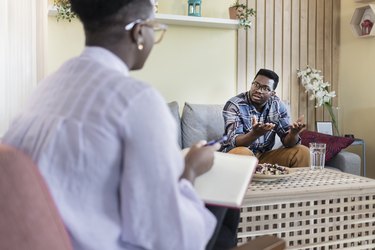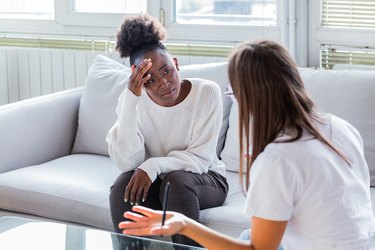
You might notice something different at your next annual doctor exam. In addition to checking your physical stats, your doctor might want to know about how you're doing emotionally.
All adults under 65 should now regularly be screened for anxiety, per a September 2022 recommendation statement from the U.S. Preventive Services Taskforce (USPSTF). Anxiety affects nearly one in five U.S. adults every year, but among them, only about 40 percent receive treatment, according to the Anxiety & Depression Association of America.
Video of the Day
Video of the Day
Screenings by primary care providers are a tool for helping more people get the mental health care that they need.
"Many patients come to the doctor with headaches, trouble sleeping or reduced appetite. Often they end up having underlying anxiety or depression. A simple screening test can pick up a lot more people that way," says Susan Trachman, MD, assistant clinical professor of psychiatry at Virginia Commonwealth University and clinical associate professor of psychiatry at George Washington University.
If you've never been screened for anxiety before, you might be wondering what the process entails. Here's a look at what happens — and what the results of your screening mean for you.
What Anxiety Screenings Do
Anxiety screenings are typically given as short questionnaires designed to look for symptoms like irritability, worry, nervousness and anxiety. They're useful for flagging signs that something might be off, so you and your doctor can explore the issue further.
"The screening itself isn't meant to diagnose someone with an anxiety disorder," explains Holly Schiff, PsyD, a licensed clinical psychologist in Greenwich, Connecticut. "It is just meant to identify those who may need extra support and mental health care."
What Happens During an Anxiety Screening
Anxiety screenings are typically conducted at your primary care doctor's office. "The USPSTF recommendations were designed to catch early signs of anxiety during routine care," Dr. Trachman says. The screening is most likely to happen during your annual physical, but if you have a visit coming up for another reason, you can also request that a screening be conducted.
The screening itself will typically happen at the start of your visit. You'll answer a series of questions (either on paper or a screen-based device like an iPad) that usually take five to 10 minutes to complete.
The specific questions will vary based on the screening tool your provider uses, "but they'll typically include questions about disruptions in daily functioning, social functioning and work, as well as questions about thinking patterns, recent sleep and eating habits and self-care," says Ashley McMann, LPC, owner of Mindful Living Therapy in Austin, Texas.
One common screening tool many docs employ is the Generalized Anxiety Disorder 7-Item (GAD-7). The questions ask focus on how you've been feeling over the past two weeks. For each question, you're instructed to reply based on a scale (not at all, sometimes or often). Some of the questions include:
- In the past two weeks, how often have you felt nervous, anxious or on edge?
- In the past two weeks, how often have you not been able to control your worrying?
- In the past two weeks, how often have you had trouble relaxing?
Will Your Doctor Think Your Answers Are Weird?
Your provider is giving an anxiety screening to help you, not judge you, so don't worry about trying to make your responses sound a certain way.
"There are no 'right' or 'wrong' answers in an anxiety screening," Schiff says. "You should answer honestly, since that helps your provider make the best assessment and evaluation of what you might need."
What Happens After the Screening?
If a screening test shows that you're having symptoms of anxiety, you and your doctor can talk about what the results might mean and what to do next.
"They'll suggest looking into it further. They might schedule a longer appointment where you can discuss your symptoms in more detail, or refer you out to a mental health professional," Dr. Trachman says. (Here's how to find the right therapist for you.)
In either case, you'll have an opportunity to get to the bottom of what your symptoms actually mean, including whether you have an anxiety disorder, and figure out the right lifestyle changes and treatment options.
Can You Take an Anxiety Screening at Home?
Anxiety screenings like the GAD-7 are available for anyone to use online, so you can certainly take one on your own. "It's a good place to start if you're worried about your level of anxiety," Schiff says.
What's more, it just might get you on the road to feeling better a little bit sooner. "Anxiety is such a common disorder and it's so treatable. People should feel empowered by the idea that they have the option of filling out a screening for themselves," Dr. Trachman says.
Just keep in mind that taking an online test — even if it's the same screening tool your doctor would use — doesn't actually diagnose you with anxiety. "Many mental health disorders either closely mimic each other or share common symptoms and it can be difficult to obtain the correct diagnosis without a proper assessment from a professional," McMann says.
Instead, think of an at-home test as a first step for learning more about your symptoms. If the results of your screening test say that you're experiencing signs of anxiety, you can use that as a jumping-off point for talking with your doctor or therapist.
Is this an emergency? If you are experiencing serious medical symptoms, please see the National Library of Medicine’s list of signs you need emergency medical attention or call 911.





